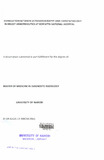Correlation Between Ultrasonography And Histopathology In Breast Abnormalities At Kenyatta National Hospital
Abstract
INTRODUCTION: Previous studies on breast masses done in Kenya were based
on assessing the value of ultrasonography as an adjunct to mammography in
evaluating breast masses and in probing usefulness of mammography in the
investigation of symptomatic patients under 30 years of age. No study has been
done in Kenya to date to correlate the ultrasonographic pattern of breast
masses with their histopathology findings.
OBJECTIVE: To compare Ultrasonographic and histopathology findings in the
diagnosis of breast abnormalities and establish the ability of ultrasonography
compared to histopathology the gold standard.
STUDY DESIGN: Prospective cross sectional descriptive study.
METHODOLOGY: Grey scale and color Doppler breast ultrasonography (BUS)
was done on fifty six patients referred on suspicion of breast disease. These
patients later as per routine practice underwent core or excisional biopsy of
the lesion where specimen for histopathology was obtained. Each breast
abnormality was characterized in terms of shape, orientation of long axis,
echopattern, margins, calcifications, acoustic shadowing or enhancement and
vascularity. Ultrasonographic and histology reports were recorded in data
collection forms. Data entry and statistical analysis was done using
microcomputer SPSS/PC+ programme.
RESULTS: A total of 56 patients were studied. The ages of the patients ranged
between 15 and 74 years. The mean age was 35 years with a standard deviation
of 14.1. At ultrasonography the commonest breast masses were ACR BIRADSUS
category 2 lesions 26 cases {46.4%}. These were followed by category 4
lesions 17 cases {30.4%} and category 5 lesions 8 cases {14.3%}. Categories 1
and 3 had 2 cases each {3.6%} while category 6 had only one case {1.8%}.
The lesions confirmed at histology included fibroadenoma 18 cases {32%},
infiltrating ductal carcinoma 21 cases {37.5%}, fibrocystic change 3 cases {5.4%},
phylloides tumor 3 cases {5.4%}, papilloma 2 cases and one case each of
fibrosis, lipoma, mastitis and abscess.
CONCLUSION: Analysis of ultrasonographic characteristics of breast masses
such as shape, orientation, margins, lesions boundary, posterior acoustic
features, calcification and assigning the mass an ACR-BIRADS assessment
category will help in differentiating benign from malignant lesions.
RECOMMENDATION: For all cases of breast masses referred for BUS, lesion
characteristics such as shape, orientation, margins, lesion boundary,
echopattern, posterior acoustic features and calcification should be analyzed
and the lesion assigned an ACR-BIRADSassessment category. This will help in
differentiating benign from malignant lesions.
Citation
Master of medicine in diagnostic imaging and radiation medicine,Univesity Of Nairobi,2010.Publisher
Univesity Of Nairobi Department Of Diagnostic Imaging And Radiation Medicine

